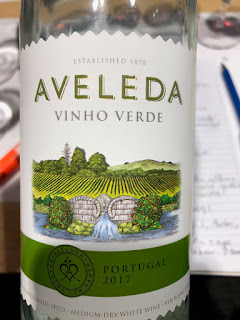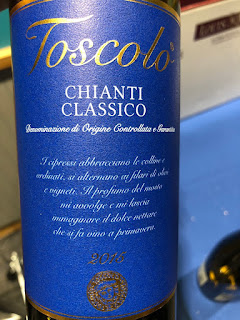 |
| This week's map homework - nice map but maybe on blank paper next time? |
This week's readings were insane - all of North and South America!
How the heck am I going to remember all of this info?
With just four weeks to go, it's pretty intimidating. Not at all like WSET 2.
In the mega-wine week, we covered bits about Canada, Oregon, New York, and Washington but spent most of our time looking at California, Chile, and Argentina.
Yes, we did leave out lots of areas but I guess those are the main ones.
The first wine we are going to look at, however, came all the way from the Okanagan, Mission Hill. We tried a 2016 Mission Hill Reserve Viognier ($22). This youthful wine had peach, melon and ginger spice aromas. On the palate, it was a really medium wine with medium acidity, body, intensity, and finish but did have high alcohol (just). It was rated as a Good wine and one that was good to drink now but not suitable for ageing.
I've already done a whole blog posting about our trip to the Willamette (rhymes with, "Damn it") Valley in Oregon - if you are interested in that, it is here. We tried one wine from there - a 2015 Sokol Blosser Pinot Noir ($48). This wine had aromas of red cherry, red plum, smoke, vanilla, and perfume. On the palate, I also tasted some leather. This wine had medium body, medium minus tannins, medium plus acidity, and a long finish. It was balanced, complex and pretty intense and would garner a Very Good rating.
If you want to try an outstanding wine from the Willamette Valley, try the 2014 Domaine Serene Evenstad Reserve that we had on our trip to Oregon. Although it cost close to $100, my wife and I opened a bottle we had squirrelled away from the trip last weekend and it was an intense, wonderful wine. I might have to buy it again, despite the hefty price.
On to California.
 |
| Courtesy Wine Folly |
Napa County is probably the most highly regarded region with a multitude of different AVAs. The wines here are expensive and prestigious. For example, there's Los Carneros which extends into Sonoma and is famous for its Pinot Noir and Chardonnay - both still wine and high end sparkling. Three big AVAs that are famous for Cabernet Sauvignon are Stags Leap, Oakville, and Rutherford, although wines from these areas are super pricey. St. Helena and Calistoga AVAs are home to Cab Sauv, Syrah, and, California's grape, Zinfandel.
Zinfandel is a tricky grape - it ripens unevenly so it has to be hand picked but when it dries a bit and turns into a bit of a raisin, it is concentrated, full bodied, with wonderful red and black fruit as well as liquorice.
Sonoma County is the other big region with AVAs such as Russian River (Pinot Noir and Chardonnay), Dry Creek Valley (Zinfandel and Sauvignon Blanc), Alexander Valley (Cab Sauv), and Sonoma Coast (elegant Chardonnay and Zinfandel). The area of Sonoma County is actually bigger than Napa.
Mendocino County includes Anderson Valley which is very cool and is home to aromatic wines like Riesling and Gewürztraminer while Mendocino AVA has full bodied Cab Sauv, Zinfandel, and Syrah.
The Central Coast hosts the Santa Cruz Mountains AVA (elegant Cab Sauv), cool Monterey (Pinot Noir and Chardonnay), Pablo Robes AVA (Cab Sauv, Merlot, and Syrah), and Santa Maria Valley (Pinot Noir and Chardonnay - concentrated fruit and high acidity).
The last area we checked out was the Central Valley. This is a mostly flat area that is hot and dry and is a lake of cheap jug wine. However, the Lodi AVA has cooling breezes from San Francisco Bay and has some of the oldest and best Zinfandel vines in California. I would LOVE to try a Zin from Lodi!
So, let's look at the Zinfandel we did try! It was a 2015 Ridge Dry Creek Zinfandel ($74). This wine burst with aromas of black plum, cassis, raspberry, violet, vanilla, and liquorice. On the palate, there was also tobacco and plum - both red and black. It was a high alcohol wine with a long finish and pronounced flavours as well as medium body and tannins. Due to its lower tannins, it was not considered suitable for ageing but it would definitely be a wine to drink now! Although our instructor rated it as Very Good, I would have to go with Outstanding.
We also tried a 2013 Darioush "Caravan" Cab Sauv from Napa Valley ($89) and it was spectacular. It had aromas of black plum, cedar, forest floor, earth, black pepper, black currant, and coffee. On the palate, this developing wine had addition tastes of tobacco and mushroom. It was a high alcohol, high acidity, medium plus tannin wine with a pronounced intensity of flavours and a long finish - a classic Napa Cab! We rated this wine as Outstanding.
Before we leave North America, we did try a wine from Washington State - if you are interested in that blog entry, it is here. I would definitely revisit that area, as I would with Oregon. The wine we tried in class was a 2013 K.Vintners Syrah from the Columbia Valley ($67). This was another really enjoyable wine with black plum. black currant, white pepper, cedar and leather on the nose. This developing wine had cedar, blackberry and cooked fruits on the palate and was a high tannin, high alcohol, medium plus body, medium plus intensity, high acid wine. It was a bit astringent with the high acid as it could have been a little more plush or ripe. This was rated as a Very Good wine with ageing potential.
For such a skinny country, Chile has a fair number of wine regions to know. First, though, the grapes that are grown there. Cab Sauv and Merlot are big grapes in Chile as well as their signature grape, Carmenere. An interesting thing about Carmenre is that it is originally a French grape that fell out of favour after Phyloxera hit. Meanwhile, in Chile, thanks to being surrounded by ocean, mountains, desert, and ice fields, Phyloxera never came there. Wine growers in Chile thought they were growing a lot of Merlot but realized that it tasted different than other Merlots. That's because it was Carmenere!
White grapes of Chile are mainly Sauvignon Blanc and Chardonnay.
The regions of Chile are hard to remember so I will just review the four big areas - Coquimbo (Sauvignon Blanc, Syrah and Chardonnay), Aconcagua (Carmenere, Syrah, Cab Sauv and some Sauvignon Blanc), Central Valley (Cab Suav, Syrah, Carmenere) and Curico and Maule Valleys (Carignan). The smaller areas to watch for when you buy wines from Chile are Casablanca, San Antonio, Leyda Valley, Maipo, Cachapoal Valley, and Colchagua Valley.
We tried just one wine from Chile. It was a Carmenere and, if you want to revisit the Carmenere in a blog post that I thought was amazing, the link is here. This one was a 2016 Calina Carmenere from the Central Valley ($24). It definitely tasted of red fruit such as cherry, plum and cranberry as well as red liquorice. It had a certain herbaceousness about it that detracted from the overall flavour. It hit all the medium spots in acid, tannins, body, etc. and was just rated as a Good wine.
There is so much to learn about Argentina but I will just hit the things that relate to the wines I tried. First, the white grape that Argentina is famous for is the Torrontes grape. It is an intensely fruit and floral grape and is definitely and aromatic grape. It is found in a number of areas including Mendoza, San Juan, La Rioja and Salta.
We tried an 2015 El Porvenir Torrontes from La Cafayate in Salta ($22). I had a difficult time deciphering the aromas of this one so I will go with the group's descriptors. On the nose were honeysuckle, melon, elderflower and orange blossom aromas in a pronounced intensity. On the palate it was dry with medium plus acidity, medium body, finish and alcohol. This 'drink now' wine was rated as Very Good.
The black grape from Argentina that is their flagship grape is Malbec. This deep purple, oaked grape is grown in Argentina more than anywhere else in the world. If the flavours are extracted gently, it can be a very elegant wine with floral aromas and spice. It can also be blended with Cab Sauv, Merlot, Cab Franc, and Petit Verdot. I have had lots of Malbecs before form Argentina and have not been overly impressed by them.
The last wine we tried, however, did impress me. It was a 2014 Bramare Malbec from the Lujan de Cujo in Mendoza ($67). Name a black fruit and it was there. I loved this wine. Black plum, blueberry, black currant - and more. It was definitely oaked with lovely cedar and tobacco but it also had that ageing flavour of barnyard, mushrooms, and earth. It was our last wine of the night so I just leaned back and sipped the contents of my tasting glass - no spitting with this one! This full bodied wine had intense aromas on the nose and pronounced flavours on the palate. This wine was balanced, had length and was complex, deserving an Outstanding rating.
Now, back to my studying!































